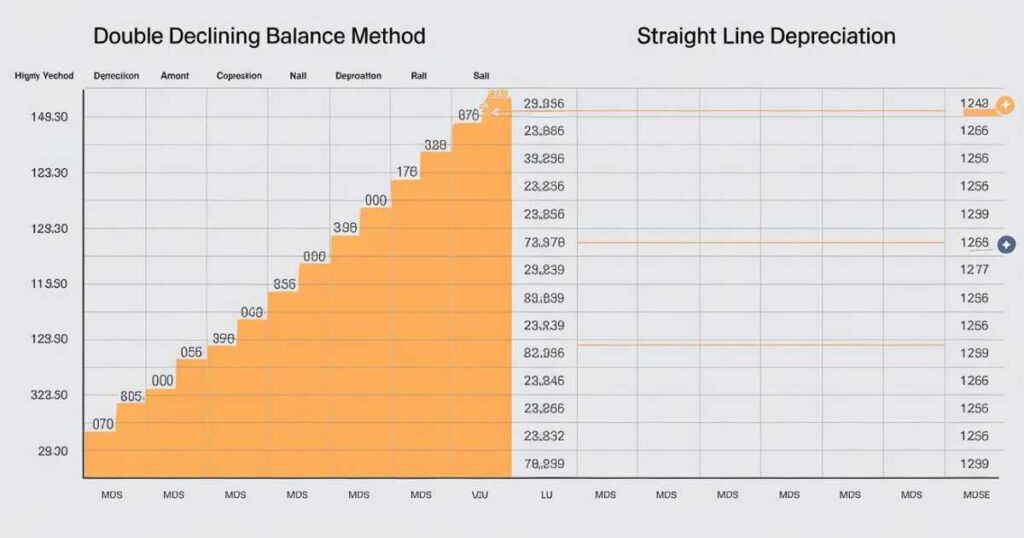The Double Declining Balance Method (DDB) is an accelerated depreciation technique. It calculates depreciation at twice the straight-line rate. DDB recognizes higher expenses in early years of an asset’s life. This method reflects faster value loss in initial years. It aligns expenses with the periods they benefit.
Double Declining Balance Method (DDB) offers valuable benefits for businesses. It represents asset value decline more realistically. Companies can reduce early-year taxable income. Double Declining Balance Method (DDB) works well for assets facing quick technological obsolescence. It impacts financial statements and tax liability significantly.
DDB requires careful application and calculation. Accountants must know the asset’s useful life and salvage value. They apply the rate to the asset’s book value yearly. Depreciation expense decreases over time. Companies may switch to straight-line depreciation later. DDB offers flexibility but needs accurate implementation.
How the Double Declining Balance Depreciation Method Works
The Double Declining Balance Method works by applying a depreciation rate that’s twice that of the straight-line method to the asset’s remaining book value each year. This results in a front-loaded depreciation schedule, where the highest depreciation expense occurs in the first year and gradually decreases over time. As the asset’s book value declines, so does the annual depreciation expense, creating a curve that reflects the rapid initial loss of value many assets experience.
Let’s walk through an example to illustrate how DDB works in practice. Imagine a company purchases a piece of machinery for $100,000 with an expected useful life of 5 years and no salvage value. Using the straight-line method, the annual depreciation rate would be 20% (100% ÷ 5 years).
With DDB, we double this rate to 40%. In the first year, the depreciation expense would be $40,000 (40% of $100,000). In the second year, we’d apply the 40% rate to the remaining book value of $60,000, resulting in a depreciation expense of $24,000. This process continues, with the expense decreasing each year as the book value shrinks.
READ MORE: Unit Elastic: The Role in Economics and Business Strategy
How to Calculate Depreciation in DDB Method
Calculating depreciation using the Double Declining Balance Method involves a few key steps. First, determine the straight-line depreciation rate by dividing 100% by the asset’s useful life in years. Then, double this rate to get the DDB rate. Apply this rate to the asset’s book value at the beginning of each year to calculate the annual depreciation expense. It’s important to note that in the final year of the asset’s useful life, you may need to limit the depreciation to avoid depreciating below the asset’s salvage value.
Double Declining Balance Method Formula (DDB)
The formula for calculating depreciation using the DDB method is straightforward:
Annual Depreciation Expense = 2 × Straight-line depreciation rate × Book value at the beginning of the year
For example, if we have an asset with a cost of $50,000, a useful life of 5 years, and no salvage value:
- Straight-line rate = 1 ÷ 5 = 20%
- DDB rate = 2 × 20% = 40%
- First year depreciation = $50,000 × 40% = $20,000
This formula allows for quick calculations, but remember to recalculate the book value each year for accurate results.
Double Declining Balance Method vs. Straight Line Depreciation

When it comes to depreciation methods, the Double Declining Balance and Straight Line methods are often compared. Both have their merits, but they serve different purposes and can lead to vastly different financial outcomes. The Straight Line method spreads depreciation evenly over an asset’s useful life, resulting in consistent annual expenses. In contrast, DDB front-loads depreciation, recognizing higher expenses in earlier years and lower expenses later on.
The choice between these methods can significantly impact a company’s financial statements and tax liability. DDB can be beneficial for businesses looking to minimize taxable income in the short term or for those dealing with assets that lose value quickly.
On the other hand, Straight Line depreciation offers simplicity and predictability, making it easier to forecast expenses. Companies must carefully consider their financial goals, the nature of their assets, and tax implications when choosing between these methods.
Double Declining Balance Method Calculator
In today’s digital age, calculating depreciation using the Double Declining Balance Method has become easier than ever thanks to online calculators. These tools can save time and reduce errors, especially when dealing with multiple assets or complex scenarios.
A good DDB calculator typically requires inputs such as the asset’s initial cost, useful life, and salvage value. It then generates a depreciation schedule showing the annual depreciation expense and remaining book value for each year of the asset’s life.
Fixed Asset Assumptions
When using the Double Declining Balance Method, it’s crucial to start with accurate fixed asset assumptions. This includes determining the asset’s initial cost, which encompasses not just the purchase price but also any costs associated with getting the asset ready for use.
You’ll also need to estimate the asset’s useful life and salvage value. These assumptions form the foundation of your depreciation calculations and can significantly impact your financial reporting and tax obligations.
Straight Line Depreciation Rate Calculation
The Straight Line depreciation rate serves as the basis for the DDB rate. To calculate it, simply divide 100% by the asset’s useful life in years. For instance, if an asset has a useful life of 8 years, the Straight Line rate would be 12.5% (100% ÷ 8). This rate is crucial because it’s the starting point for determining the accelerated rate used in the Double Declining Balance Method.
Double Declining Depreciation Rate Calculation
To arrive at the Double Declining depreciation rate, we simply double the Straight Line rate calculated in the previous step. Continuing with our example, if the Straight Line rate is 12.5%, the DDB rate would be 25% (12.5% × 2). This higher rate is what gives the DDB method its accelerated nature, allowing for larger depreciation expenses in the early years of an asset’s life.
Annual Depreciation Expense Calculation (DDB)
Calculating the annual depreciation expense using the Double Declining Balance Method involves applying the DDB rate to the asset’s book value at the beginning of each year. In the first year, this is straightforward – simply multiply the asset’s initial cost by the DDB rate.
In subsequent years, you’ll need to subtract the accumulated depreciation from the initial cost to get the current book value before applying the rate. This process continues year after year, with the depreciation expense typically decreasing over time as the book value diminishes.
conclusion
Double Declining Balance Method offers a powerful way for businesses to accelerate depreciation on their fixed assets. By front-loading depreciation expenses, companies can potentially reduce their tax liability in the short term and better match expenses with the actual decline in asset value.
It’s important to carefully consider the implications of using this method and to ensure it aligns with your overall financial strategy. Whether you’re a small business owner or a financial professional, understanding and correctly applying the DDB method can be a valuable skill in managing your assets and optimizing your financial reporting.

Howdy, editor at FinanceEon.com, brings over a decade of financial journalism experience. He ensures accuracy and insightful analysis, guiding a team on market trends and investment strategies.







